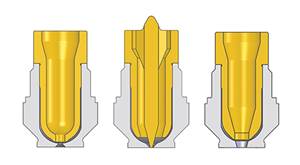Sharper Dies Make for Smoother Extrusions
Dies that have a radius at the exit will result in poorer surface finish.
A number of die-flow issues can affect surface finish, but one that’s often overlooked is the “sharpness” of the die exit geometry. Polymers will stick to the die surfaces unless you use additives such as fluoropolymers, which can lend a degree of stick/slip flow.
Moreover, all polymers have some degree of die swell due to molecular orientation that occurs in the die exit. This is due to uniaxial flow, which untangles the long polymer chains in the direction of flow. Once relieved of the flow velocity, the polymer returns quickly to its “relaxed” state and reorients to a random configuration. This results in expansion, primarily in the transverse direction, both horizontally and vertically, and is referred to as swelling of the extrudate. Die swell increases with velocity, reduced land length, decreasing temperature, and the molecular properties of the polymer. Adhesion to the die surface, combined with die swell, causes the polymer to flow along the face of the die after the exit if there is not a sharp break-off point, rather than moving directly downstream away from the die face. This situation is exacerbated by any radius on the die exit, which causes the polymer to continue following the die surface because of the combined effects of adhesion and swelling. Such exit radii are not usually there by design but are caused by periodic maintenance and/or gauging. Contacting the exit edges of the die with hard objects will eventually wear the sharp edge, creating a radius.
Although it’s wise to use soft tools to clean the die, it should be noted that all metals that have a “gold” color are not necessarily soft. Typical low-carbon steel has a Rockwell Hardness (Rb) of less than 71. Pure copper has a typical Rb of <10, but some copper alloys are as hard as 98 Rb while brass alloys can be 63 Rb. It’s not uncommon to observe operators using razor knives, steel spatulas, hardened drills, steel-wire brushes, stainless feeler gauges, and even screw drivers to work on the die. These types of tools are often harder than the die-exit edges unless the edges are made of heat-treated, high- carbon steel, and as a result can wear them quickly.
The “breakaway” effect for a sharp edge is contrasted by one with a radius in the accompanying figure. The polymer tends to follow the radius because of its adhesion to the wall, and then swell when it needs to break away cleanly from the die face and move downstream. This can cause micro-tearing of the surface and leave polymer on the radius or above it on the die face as die buildup. The combination of tearing along with die buildup is often a largely invisible cause of poor surface finish on the extruded part. A radius as small as 0.010 in. has been found to result in surface tearing and die-face buildup with certain polymers.
Obviously dies periodically need cleaning, and if aggressive cleaning is necessary, even what are believed to be protective materials such as brass are hard enough to abrade a die’s sharp edges, creating a radius or chamfer. To counter this effect, the die-exit face may need periodic resurfacing to restore the sharp edge. This can be done by surface grinding, but requires removing and disassembling the die, resulting in extended downtime.
Simply using only soft copper scrapers, gauze, feeler gauges and other tools can prevent this abrasion and many surface defects.
ABOUT THE AUTHOR: Jim Frankland is a mechanical engineer who has been involved in all types of extrusion processing for more than 40 years. He is now president of Frankland Plastics Consulting, LLC. Contact jim.frankland@comcast.net or (724) 651-9196.
Related Content
The Importance of Melt & Mold Temperature
Molders should realize how significantly process conditions can influence the final properties of the part.
Read MoreHow to Optimize Pack & Hold Times for Hot-Runner & Valve-Gated Molds
Applying a scientific method to what is typically a trial-and-error process. Part 2 of 2.
Read MoreA Simpler Way to Calculate Shot Size vs. Barrel Capacity
Let’s take another look at this seemingly dull but oh-so-crucial topic.
Read MoreHot Runners: A View from the Bottom Up
Addressing hot-runner benefits, improvements, and everyday issues from the perspective of decades of experience with probably every brand on the market. Part 1 of 2.
Read MoreRead Next
Lead the Conversation, Change the Conversation
Coverage of single-use plastics can be both misleading and demoralizing. Here are 10 tips for changing the perception of the plastics industry at your company and in your community.
Read MoreAdvanced Recycling: Beyond Pyrolysis
Consumer-product brand owners increasingly see advanced chemical recycling as a necessary complement to mechanical recycling if they are to meet ambitious goals for a circular economy in the next decade. Dozens of technology providers are developing new technologies to overcome the limitations of existing pyrolysis methods and to commercialize various alternative approaches to chemical recycling of plastics.
Read MoreProcessor Turns to AI to Help Keep Machines Humming
At captive processor McConkey, a new generation of artificial intelligence models, highlighted by ChatGPT, is helping it wade through the shortage of skilled labor and keep its production lines churning out good parts.
Read More.jpg;width=70;height=70;mode=crop)









